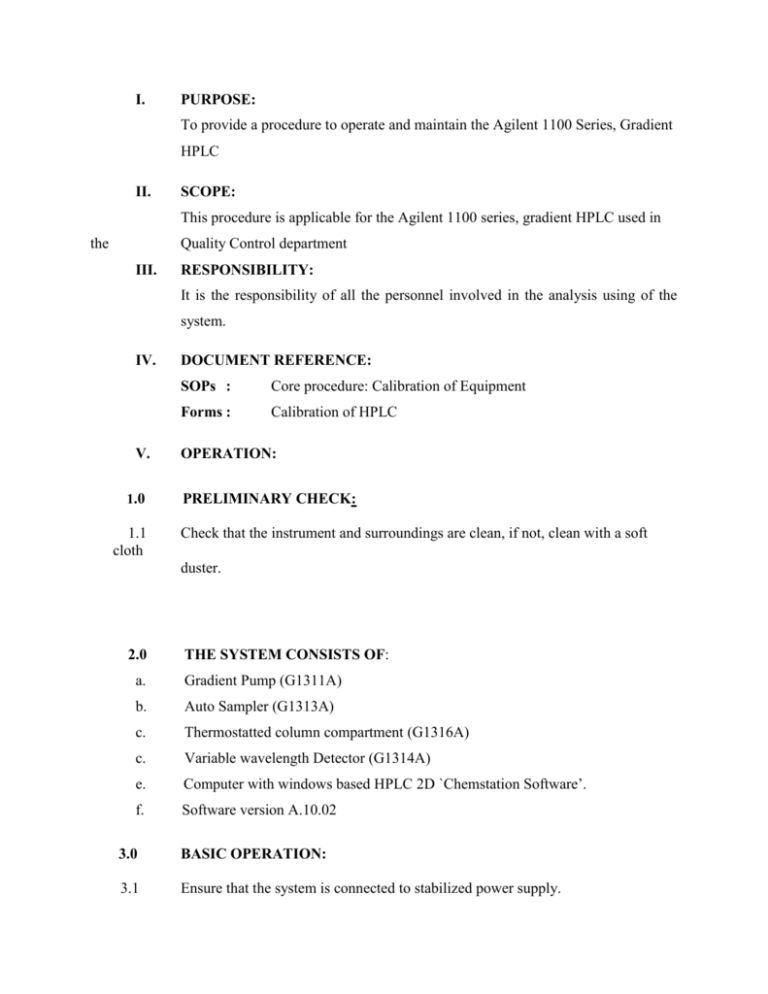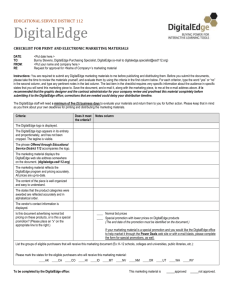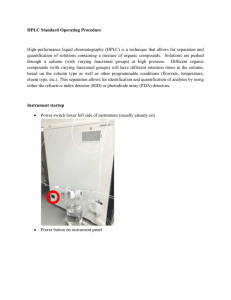To provide a procedure to operate and maintain the
advertisement

I. PURPOSE: To provide a procedure to operate and maintain the Agilent 1100 Series, Gradient HPLC II. SCOPE: This procedure is applicable for the Agilent 1100 series, gradient HPLC used in the Quality Control department III. RESPONSIBILITY: It is the responsibility of all the personnel involved in the analysis using of the system. IV. V. 1.0 1.1 cloth DOCUMENT REFERENCE: SOPs : Core procedure: Calibration of Equipment Forms : Calibration of HPLC OPERATION: PRELIMINARY CHECK: Check that the instrument and surroundings are clean, if not, clean with a soft duster. 2.0 THE SYSTEM CONSISTS OF: a. Gradient Pump (G1311A) b. Auto Sampler (G1313A) c. Thermostatted column compartment (G1316A) c. Variable wavelength Detector (G1314A) e. Computer with windows based HPLC 2D `Chemstation Software’. f. Software version A.10.02 3.0 BASIC OPERATION: 3.1 Ensure that the system is connected to stabilized power supply. 3.2 Put on the main switch of the instrument. Identify the column to be used for the Analysis and make relevant entries in the HPLC column register. 3.3 Connect the prescribed column in the right direction, connect the tubing from the injector to one end of the column and other end to the tubing from the detector. 3.4 Start-up procedure for `Chem-station’ Switch on the LC-modules in the following manner: 3.4.1 Switch `ON’ the main for pump. 3.4.2 Switch `ON’ the main for autosampler. 3.4.3 Switch `ON’ the main for column thermostat. 3.4.4 Switch `ON’ the main for detector. 3.4.5 Switch `ON’ the computer. 3.5 Operating procedure for `Pump’ 3.6 For Purging - Operation 3.6.1 Click to switch on / off the pump. 3.6.2 Open the purge valve by turning it in the anti-clockwise direction. Put on the pump by clicking on instrument and selecting `Set up pump’. 3.6.3 Enter the required flow. Ensure that there is no air-bubble in the tube. Close the purge3.6.4 3.6.5 valve. Enter the stop-time and click on OK. Give the % flow rate of each pump and generate gradient programme using the table according to the specific method details 3.7 Operating procedure for `Injector’ 3.7.1 Click ↗ to switch on the injector. 3.7.2 Click on `Instrument’ and select `Set up injector’. 3.7.3 Enter injection volume and click on OK. 3.8 Operating procedure for `Column-Thermostat’ 3.8.1 Click on to switch on/off the thermostat. 3.8.2 Click on `Instrument and select `Set up column - thermostat’. 3.8.3 Enter the desired temperature and click on OK. If temperature is not required click on `Not controlled’. 3.9 Operating procedure for `VWD-Detector’ 3.9.1 Click on 3.9.2 Click on `Instrument’ and select `Set-up’ VWD-signal. 3.9.3 Enter the desired wavelength and click on OK. 3.10 Set up method for single - Injection to put on/off the detector. 3.10.1 Click on `VIEW’, click on `METHOD & RUN CONTROL’. 3.10.2 Click on `RUN CONTROL’ and select `Sample Info’. 3.10.3 Enter the operator’s name, prefix & counter, vial number, sample name, click on `OK’. 3.10.4 After single run enter the required parameter, click on ‘METHOD’ and select ‘Save Method As’ & save the method by any name. 3.11 Set up method for sample sequence 3.11.1 Click on `Sequence’. 3.11.2 Select `Sequence Table’ and click on `APPEND LINE’ give the vial number, sample name, method name, injection/vial, injection volume, click `OK’. 3.11.3 Save sample sequence as follows. Click `SEQUENCE’, click `SAVE SAMPLE SEQUENCE AS’, give name to save sample sequence , click `OK’. 3.11.4 Click on sequence, click on `SEQUENCE PARAMETER’, enter operator’s name, enter prefix, counter, click `OK’. 3.12 Procedure for Reintegration of Chromatograms 3.12.1 Click on `VIEWS’. 3.12.2 Click on `Data Analysis’. 3.12.3 Click on `File’ and select `Load Signal’, Load Chromatogram number. 3.12.4 Click on integration and select `Integration-event’. Give the desired integration events and integrate the chromatograms. 3.13 Procedure for Report Layout In `Data Analysis’ click `Report’ then `Specify Report’. Desired report layout can be chosen in `Report style’. Click signal options for changing time range and response range. 3.14 To exit on-line: Save the above parameters by giving a method name. To come out of HPChemstation click file and exit. VI. CALIBRATION months Calibration frequency: Once in three 1.0 Calibration of the pump 1.1 Check the flow rate of the filtered and degassed Purified water as follows: 1.2 Disconnect any column if connected to the system and connect restriction capillary 1.3 Set the flow of the pump at 1.0 mL per minute. Keep the system at this flow rate for about 5 minutes to equilibrate the system. 1.4 Collect the volume of water delivered for 5 minutes and determine the weight of the water . 1.5 Convert the weight in to volume by the following table: Volume, in Temperature, mL, Temperature, Volume, in mL, °C of 1g of water °C of 1g of water 20 21 22 23 24 25 1.0028 1.003 1.0032 1.00345 1.0037 1.0039 26 27 28 29 30 1.0042 1.0045 1.0047 1.005 1.0053 Flow = Volume Obtained Time measured 1.6 Repeat the above for 2 and 3 mL flow rates. 1.7 Acceptance criteria: Flow rate: + 0.1mL 2.0 Column compartment thermostat / oven calibration. 2.1 Disconnect any column if connected to the system. 2.2 Purge the system with Purified water to remove any solvents and previous buffer salts. 2.3 Connect a restriction capillary of dimension 2m x 0.12 mm ID in place of column. 2.4 Keep a flow rate of 1.0 mL/minute. 2.5 Keep the sensor wire of the traceable digital thermometer in the right side of the column thermostat/ oven. 2.6 Set the temperature at 10.0°C.Wait till the set temperature is attained and the temperature display on the instrument is stable. 2.7 Wait for 5 minutes before readings are taken so that the temperature on the Instrument and that displayed on the thermometer are stable. 2.8 Note down the temperature displayed by the instrument and the thermometer. 2.9 Repeat the steps 2.6 to 2.8 for temperature settings at 20°C,30.0°C, 40.0°C,50.0°C 60.0°C& 70.0°C. 2.10 Shift the thermometer sensor wire to the left side thermostat and repeat the exercise. 2.11 Acceptance Criteria: The difference between the set temperature and the displayed temperature on the thermometer should not be more than ± 2.0°C. 3.0 Calibration of the Detector Lamp Intensity: 3.1 Pass the purified water for 10 to 15 minutes through the flow cell. 3.2 Switch on the detector and wait for 5 minutes. 3.3 Click on ‘Diagnosis’. 3.4 In ‘Diagnosis’, 4 windows appear - pump, ALS, Thermostat and VWD. 3.5 Select ‘VWD’ for intensity test and again click on ‘Show module tests’. 3.6 Display shows procedures list. 3.7 Select ‘VWD’ intensity test and click on ‘Start’ button. 3.8 After 2-3 minutes, lamp intensity spectrum appears on screen. 3.9 Acceptance Criteria: INTENSITY LIMIT: Range: Limit in counts (NLT) Highest intensity > 10000 Average intensity > 5000 Lowest intensity > 200 4.0 Baseline Noise & Temperature Stability Test: 4.1 Chromatographic conditions: Column Mobile phase Flow rate Column Oven Temperature : Restriction capillary 2m x 0.12 mm ID : Filter and degas purified water. : 1.0 mL/ min. : 40°C 4.2 Install the column in the column thermostat and switch on the UV detector. Equilibrate for at least 1 hour. 4.3 When in ‘Method and Run Control’, click on ‘Verification (OQ/PV)’. 4.4 Select ‘instrument verification’ and click on ‘Edit’. 4.5 Select ‘Noise/Temperature stability’ and click on ‘Append’. 4.6 Click on ‘Setup’, enter the limit as follows and click on ‘OK’ For ASTM (mAU ) For Wander ( mAU ) For Drift (mAU/h) For Temperature stability (Left) For Temperature stability (Right) 4.7 : Not more than 0.040 : Not more than 0.20 : Not more than 0.50 : Not more than 0.50 : Not more than 0.50 Click on ‘Run Verification’. A message is displayed stating that whether all instrument conditions for holmium test are set as desired. If the instrument conditions are set as stated above, click on ‘Yes’. 4.8 The ‘Noise/Temperature stability starts and is displayed as ‘‘Noise/Temperature stability - Running’. 4.9 After completion of test, the status is displayed as ‘Passed’ or ‘Failed’. 4.10 Click on ‘OK’, the original mode ‘Verification (OQ/PV)’ is displayed. 4.11 To print the data of performed test. Select ‘File’, and click on ‘Print’. 4.12 Acceptance Criteria : ASTM Noise (mAU) : Not more than 0.040 Wander (mAU) : Not more than 0.20 Drift (mAU/h) : Not more than 0.50 Temperature stability (Left) : Not more than 0.50 Temperature stability (Right) : Not more than 0.50 5.0 Wavelength accuracy (VWD) (By using caffeine) 5.1 Set the following chromatographic conditions. Mobile phase : Filtered and degassed purified water. Flow rate : About 1.0 mL/minute ( NOTE : Flow changes to 0.1 mL/min while performing the test ) Column : Restriction capillary 2m x 0.12 mm ID. 5.2 Sample preparation: Weigh accurately about 25 mg of caffeine into a 100 mL volumetric flask, dissolve and dilute to volume with purified water. Further dilute 10 mL of this solution to 100 mL with purified water. 5.3 keep Install the restriction capillary in the column thermostat and equilibrate at 40°C and sample solution in vial number 4. 5.4 Switch ON the column compartment and detector UV lamp for at least 1 hour. 5.5 method and run control’, click on ‘View’ and select ‘verification (OQ/PV)’. 5.6 Click on ‘instrument verification’ and click on ‘edit’. 5.7 Select ‘Wavelength accuracy’ and click on ‘append’. 5.8 Click on ‘Set up’, enter the limit 2 in all the three fields and click on ‘OK’. 5.9 Click on ‘run verification’. A message is displayed stating that whether all instrument conditions for accuracy test are set as desired. If the instrument conditions are set as stated above, click on ‘yes’. 5.10 The accuracy test starts and is displayed as ‘running’. 5.11 After completion of the test, the status is displayed as ‘passed’ or ‘failed’. Click on ‘OK’, the original mode is displayed. 5.12 To print the data, select ‘file’ and click on ‘print’. ` 5.13 Acceptance Criteria: Standard Absorbance Maxima 205 nm 245 nm Limit 203 nm to 207 nm 243 nm to 247 nm 273 nm 271 nm to 275 nm 6.0 Wavelength accuracy (By Holmium Oxide Test) 6.1 Pass the purified water for 10 to 15 minutes through the flow cell. 6.2 Switch on the detector and wait for 5 minutes. 6.3 When in ‘Method and Run Control’, click on ‘Verification (OQ/PV)’. 6.4 Select ‘instrument verification’ and click on ‘Edit’. 6.5 Select ‘Holmium’ and click on ‘Append’. 6.6 Click on ‘Setup’, enter the limit ‘2’ and click on ‘OK’. ` 6.7 Click on ‘Run Verification’. A message is displayed stating that whether all instrument conditions for holmium test are set as desired. If the instrument conditions are set as stated above, click on ‘Yes’. 6.8 The Holmium test starts and is displayed as ‘Holmium - Running’. 6.9 After completion of test, the status is displayed as ‘Passed’ or ‘Failed’. 6.10 Click on ‘OK’, the original mode ‘Verification (OQ/PV)’ is displayed. 6.11 To print the data of performed test. Select ‘File’, and click on ‘Print’. 6.12 Select the parameters as desired to be printed and click on OK. 6.13 Acceptance Criteria: Standard Absorbance Maxima 360.8 nm 418.5 nm 536.4 nm Limit 359.8 nm to 361.8 nm 417.5 nm to 419.5 nm 535.4 nm to 537.4 nm 7.0 Precision and linearity of auto injector and detector response. 7.1 Chromatographic conditions: Column : ODS C18 15 cm x 4.6 mm, 5 microns (Inertsil ODS-2 column is suitable) Mobile phase : Acetonitrile : Purified water (15 : 85 v/v).Filter and degas Flow rate : 1.0 mL / min. Wavelength : Run time : Injection volume : Column oven temp. : 7.2 273 nm 10 minutes 10, 20, 50 and 100 µL 36°C Preparation of standard solution: Weigh accurately 25 mg of caffeine into a 100 mL volumetric flask, dissolve and dilute to volume with mobile phase. Further dilute 10 mL of this solution to 100 mL with mobile phase. 7.3 Inject 10µL, 20µL, 50µL & 100µL of the standard solution in five replicates and record the chromatograms. 7.4 Theoretical plates of caffeine peak should not be less than 3000 and tailing factor should not be more than 2.0 ( As per USP) for 20µL injection 7.5 Calculate the % RSD of the peak areas of caffeine from the 5 replicate injections at each level. 7.6 Calculate the % RSD of the retention time of caffeine from the 5 replicate injections at each level. 7.7 Plot a linearity graph between injection volume on the X axis and average area of caffeine at level on the Y axis. 7.8 Acceptance Criteria : 1) The % RSD of retention time of caffeine from the five replicate injections at each level should be less than 1.5 2) The % RSD of peak areas of caffeine from the five replicate injections at each level should be less than 2.0 3) The correlation coefficient ‘r’ obtained from the linearity graph of caffeine for different levels should not be less than 0.999 8.0 GRADIENT ACCURACY 8.1 Chromatographic Conditions: Column : Hypersil ODS 100 x 4.6 mm ID, 5 or equivalent Detector wavelength : 254 nm Injection volume : 20 L Flow rate : 2mL/min Runtime : 30 minutes obile Phase A : Water generated by Milli-Q Apparatus Mobile phase B : 0.3%v/v Acetone in filtered water generated by Milli-Q obile Phase 8.3 Preparation of Mobile Phase B: Take 3 mL of acetone in 1000 mL of water generated by Milli-Q Gradient program : Time (min) 0.01 2.00 2.01 8.00 8.01 13.00 13.01 18.00 18.01 23.00 23.01 30.00 Mobile phase B percentage 0 0 10 10 50 50 90 90 100 100 0 0 8.4 Procedure: Open the drain valves and purge the flow lines of both pumps Equilibrate the column with initial concentration with above mentioned conditions and wait until the baseline is stable Adjust the baseline level to fit the full Scale of the integrator Inject exactly 20 L of mobile phase A and start the time program for gradient accuracy test. Determine the signal level at 0%(B Con), 10%(B Con), 50%(B Con), 90%(B Con) and 100%(B Con) Calculate the actual B concentration level at 10%(B Con), 50%(B Con), 90%(B Con) Using 0% (B Con) and 100% (B Con) Calculation: Calculate the actual B concentration level at 10% = B concentration level at 10% - B concentration level at 0% B concentration level at 100% - B concentration level at 0% x 100 Similarly calculate the actual B concentration level at 50%(B Con) and 90%(B Con) Acceptance Criteria : At B concentration 10% level should be between 9.0 and 11.0 At B concentration 50% level should be between 49.0 and 51.0 At B concentration 90% level should be between 89.0 and 91.0 8.5 Follow the procedure 8.1 to 8.4 exactly using C & D channels instead of A& B 9.0 CARRY OVER TEST: 9.1 Chromatographic conditions: Column : ODS C18; 15 cm x 4.6 mm, 5 microns (Inertsil ODS-2 column is suitable) Mobile phase : Acetonitrile : Purified Water (15 : 85 v/v).Filter and degas Flow rate : 1.0 mL / min. Wavelength : 273 nm Run time : 10 minutes Column oven temp. : 36°C Injection volume : 100 µL Preparation of standard solution: 9.2. Weigh accurately 25 mg of caffeine into a 100 mL volumetric flask, dissolve and dilute to volume with mobile phase. 9.3 Inject 100 µL of standard solution and note down the chromatogram. 9.4 After completion of the test solution inject 100 µL of blank 3 times and 100 µL of blank again blank by keeping wash vial with out septa . 9. 5 Calculated any carry over of caffeine in the last blank. 9.6 Acceptance Criteria: Carry over should not be more than 0.03% of 100-µL caffeine std peak area. 10.0 Software calibration. 1) Perform the validation of the software once in every year 2) And whenever software is updated. 11.0 If the instrument fails in calibration, proceed as per the Core Procedure, “Calibration of Equipment”.








